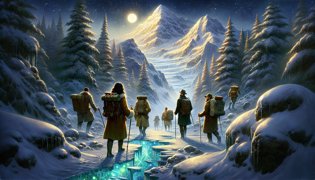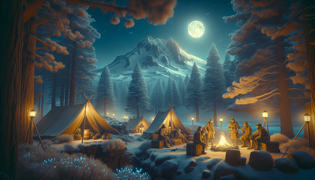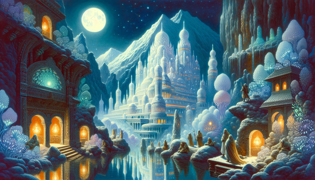The Lemurians of Mount Shasta: Secrets Beneath the Snowy Peak
Reading Time: 11 min

About Story: The Lemurians of Mount Shasta: Secrets Beneath the Snowy Peak is a Legend from united-states set in the 20th Century. This Descriptive tale explores themes of Nature and is suitable for Adults. It offers Cultural insights. An intrepid expedition uncovers the ancient inhabitants hidden under Mount Shasta’s icy heart.
Introduction
Long before most shoulders bowed under the weight of modern haste, Mount Shasta stood like a sentinel, its snowy crest wreathed in swirling clouds. Folks in the nearby towns spoke of whispers beneath the ice, murmurs carried on the wind as though the mountain were telling secrets made of snowflakes. Ever since 1900, tales have told of the Lemurians—descendants of a lost civilisation believed to have taken refuge deep under Shasta’s frozen veil.
I arrived one crisp morning, breathing in the tang of pine resin that clung to the air. The crunch of frost under my boots echoed like the careful ticking of a clock. Locals claimed their grandfathers caught glimpses of faint green glows beneath the rocks, “like finding water in a desert.” Aye, I thought, it sounded as pat as a tall tale. Yet, the stars overhead shone with a kind of impatience, as if urging me onward.
Our expedition assembled at Camp Henderson, scarves wrapped snugly against the biting breeze. Despite the nip on my cheeks, a sense of warmth blossomed in my chest—half excitement, half dread. Everywhere I looked, the mountain’s slopes rose like a colossal tapestry of ice and stone. In that moment, I realised that to climb Shasta was more than a physical feat; it was a journey into the very heartbeat of the earth itself.
A crack of distant ice startled me, reminding me that the mountain was alive. And so, with pickaxe and lantern in hand, I plunged into legend, ready to strike it rich in truth rather than gold. Aye, I might be chasing ghosts, but sometimes a scholar must chase a dream down winding corridors of myth. The needles of frost at my collar whispered: onward.
The Frozen Summit
Camp Henderson sat like a forgotten relic at the mountain’s foot, tents huddled against swirling flurries and half-frozen pines. The scent of smouldering embers drifted from the cooking fires, mingling with the bracing perfume of snow-bound juniper. A crisp hush enveloped the camp until someone struck a lantern and voices rose in hopeful murmurings.
Edward, our geologist, tapped a leather-bound journal. “This map shows a fracture here,” he explained. His finger traced a faint line across the glacier’s edge. “Legends say it’s the crack that leads to the heart.” I noticed how lantern light danced on his spectacles, like a pair of watchful eyes.
We set off at dawn. The gravel grit beneath our boots was sharp as broken glass. Wind howled down the ridge, rattling ice-laden branches and stirring distant echoes. Twice I paused to taste the air—clean and so cold it stung my lungs. Yet every breath felt sacred.
Climbing higher, we passed basalt outcrops carved by ancient glaciers, their surfaces polished to glass. I ran my gloved hand over one arch, feeling its surface as smooth as a marble urn. It was in such places that the mountain seemed to whisper of ages before humankind—when Shasta rose from primordial seas.
By midday, we reached an alcove draped in icicles like chandeliers. Beneath them lay a narrow fissure, dark as a raven’s wing. “This is where it begins,” whispered Miriam, our linguist, eyes shining. She pressed her ear to the rock and swore she heard a faint hum, as if distant drums were calling.
With heart pounding, I lit a carbide lamp and crawled inside. The passage narrowed until I had to wriggle through on all fours. Behind me, Edward’s lantern bobbed like a wayward star. A smell of damp earth rose, mingled with an unfamiliar sweetness, like jasmine carried on a subterranean breeze. That fragrance promised wonders.
At last, the tunnel opened. Soft green light spilled from veins in the walls, painting our breath in emerald hues. We stood in awed silence. The summit’s roar faded away. Here, beneath the frozen crown of Shasta, lay a gateway to a realm older than memory.

The Hidden Passage
The tunnel walls shimmered with veins of mineral that glowed faintly, like fireflies trapped beneath ice. Each step echoed, a hollow drumbeat that seemed to hail us deeper into the mountain’s innards. My gloves came away damp and cool, slick with condensation that tasted faintly of earth and sea.
Ahead, Miriam ran slender fingers along carved symbols—serpentine lines and spirals that entwined like lovers. She murmured translations in hushed tones: ‘Sanctuary of Light’, ‘Keepers of the Deep’. The glyphs were ancient, yet their meaning felt urgent, as though left as a calling card for those brave enough to heed it.
We pressed on, slipping past ice curtains that dripped rivulets into shallow channels. The water was clear and tasted of limestone, cold as a winter dawn. I knelt to cup a handful, marvelled at its purity, then poured it back where it belonged. “We ain’t just trespassers,” I whispered. “We’re pilgrims to something grander.”
The fissure opened into a cavern wide enough to cradle a church. Stalactites dripped in rhythmic harmony, while below, a carpet of emerald moss cushioned our footsteps. The air thrummed with subtle vibrations, as though the mountain itself were breathing beneath a veil of rock.
Edward took a sample of a crystalline deposit that sparkled like powdered diamonds. “This composition’s unknown,” he said, voice trembling. “It’s not from any geological period I’ve studied.” His flashlight haloed the crystals, casting prismatic rainbows that danced on the walls.
A soft hum arose, low and soothing, filling the chamber like a lullaby. We followed the sound through winding corridors, guided by patches of phosphorescent fungus that glowed like distant lanterns. Miriam hummed an old mountain tune, her voice a thread weaving through the cavern’s hush.
At the tunnel’s end lay a stone archway, carved in relief with figures of human form and fish, each holding a staff topped with a star. Above the portal, an inscription read: ‘Enter with Respect, Depart with Wisdom’. The words sent a thrill through my spine—an invitation and a warning entwined in one.

The City of Light
We emerged into a vast hall that glowed with gentle luminance. Crystal spires soared overhead like frozen sentinels, their facets refracting the pale light into rainbow splinters. Beneath our boots, the floor was polished white marble, cool to the touch as if the mountain were offering its own alabaster gift.
A hush fell. The scent of damp limestone mingled with a sweet, unfamiliar perfume—something floral, as though hidden gardens bloomed in secret chambers. Far above, a domed ceiling opening let in shafts of sunlight, giving the impression of dawn eternal.
Figures in flowing robes glided between columns carved with motifs of sea creatures and birds. Their skin bore a faint luminescence, veins of turquoise tracing delicate lines across pale flesh. One reached out to offer us thin blades of metal that glimmered like quicksilver. They welcomed us with quiet smiles and eyes that seemed to hold ages in their depths.
Miriam bowed and introduced us. The visitor before us called herself Inaara, Keeper of the Lightways. Her voice was soft, yet it filled the chamber like wind through harps. She spoke of Lemuria, a land that sank beneath the waves, and of those who fled beneath Shasta’s ice to preserve their knowledge and harmony with earth and star.
We walked through gardens of bioluminescent flora—tall stalks crowned with glowing petals, perfume drifting in gentle waves. I brushed a bloom; its petals were velvety, warm against my glove. A trickle of music rose, mechanical yet organic, like the hum of a living instrument tuned to the mountain’s pulse.
Inaara led us to a central pool of crystalline water. She dipped a slender staff into it, and symbols shimmered on the surface—stars, comets, winding galaxies. “This is our library,” she said. “Every story we’ve carried is etched here.” A ripple of light spread across the water like the breath of a great leviathan.
We stayed in silence, hearts full of wonder. Here, under Mount Shasta, was a civilisation both alien and achingly familiar—a tapestry of compassion woven into marble and crystal. I felt a tremor of gratitude and a pang of responsibility. We were visitors in a realm older than most myths.

The Encouragement of Shadows
In a hall carved from veined ice, a Lemurian council convened. Shadows danced on towering pillars as lanterns flickered like white roses in the gloom. The air tasted of mineral water and ancient incense, a blend that set the mind alight with reflection.
Inaara spoke first, her fingers tracing patterns in the frost. “Our people face a turning point,” she explained. “Some wish to rise again to the sun. Others fear the world beyond the ice.” Her words hung between us like a suspended glacier.
Edward stepped forward, voice steady. “The surface has wars, machines and hunger. It is not a safe haven.” He let the silence settle, heavy as unmelted snow.
A murmur ran through the chamber. One elder, draped in robes of pale silver, raised a slender staff. “Yet we must not remain prisoners of our fear. We once taught the world harmony. The world may yet learn from us.” Her eyes gleamed with resolve.
I felt my heart hammer. “If Lemurians return, humankind might exploit your knowledge or damn you to the same fate as Atlantis,” I said. My voice echoed against the walls, a stubborn drumbeat. “I stand with preservation—both of your legacy and your safety.”
Miriam translated my plea, adding that our world still yearns for wisdom in small-town gatherings and city squares. She spoke of rivers poisoned and forests felled, and of hearts aching for hope. The chamber grew so silent you could have heard a snowflake fall.
Finally, Inaara nodded. “We will share a fragment of our light,” she said. “Not as conquerors, but as humble guides.” A hush of relief rippled through the council. I realised then that shadows and light must dance together to shape any dawn.
Outside, the mountain seemed to sigh. The ice hummed in assent. We set forth at dawn, carrying sealed vials of liquid crystal and etched tablets of guidance. The path back up was steep, but our spirits soared. We climbed like miners driven to strike it rich—with knowledge as our treasure.
Above, the sun crowned the summit. And for a moment, the mountain shone as if grinning at us, its ancient heart now beating in tandem with ours.

Conclusion
Back at Camp Henderson, dawn broke in a blush of rose and gold. The mountain’s slopes glowed softly, as though aware of secrets returning to the sun. We packed our gear in silence, each of us burdened and buoyed by the gravity of what we carried. The vial of crystal light felt cool in my palm, a promise of wisdom and temperance.
Miriam fixed her pack and laughed softly, the sound like the unclasping of a long-held chord. “We did it,” she said, breath visible in the chill. “We bridged two worlds.” I nodded, eyes misting as the pine resin’s sharp scent reminded me of home.
Edward secured the last sample and gazed up at the peak. “It’s like the mountain itself gave its blessing,” he murmured. I could almost feel Shasta’s heartbeat echoing through my boots.
On the descent, we spoke little. Every step felt sacred, each crest a threshold between realms. When we reached the tree line, the sun warmed our faces like a kindly hand. I turned back once, glimpsing the summit crowned in drifting clouds.
They say Shasta has many voices. Now I know some speak in crystal and marble, in corridors of glow and in the soft laughter of marble fountains. The Lemurians slipped back into legend that afternoon, leaving only whispers and footprints in the snow.
As the valleys opened before us, I carried their story in my bones. It’s a tale of ice and light, of shadows that encourage and wonders that endure. May those who listen take care, for the mountain still hums with hidden life. And in that hum lies the promise of balance between earth and sky.

















